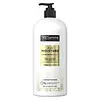What's inside
What's inside
 Key Ingredients
Key Ingredients

 Benefits
Benefits

 Concerns
Concerns

 Ingredients Side-by-side
Ingredients Side-by-side

Water
Skin ConditioningCetearyl Alcohol
EmollientDimethicone
EmollientStearamidopropyl Dimethylamine
EmulsifyingBehentrimonium Chloride
PreservativeTocopheryl Acetate
AntioxidantAscorbic Acid
AntioxidantPanthenol
Skin ConditioningBiotin
AntiseborrhoeicNiacinamide
SmoothingParfum
MaskingDipropylene Glycol
HumectantLactic Acid
BufferingAmodimethicone
Sodium Chloride
MaskingDisodium EDTA
PEG-7 Propylheptyl Ether
Emulsion StabilisingCetrimonium Chloride
AntimicrobialMethylchloroisothiazolinone
PreservativeMethylisothiazolinone
PreservativeAmyl Cinnamal
PerfumingLimonene
PerfumingLinalool
PerfumingWater, Cetearyl Alcohol, Dimethicone, Stearamidopropyl Dimethylamine, Behentrimonium Chloride, Tocopheryl Acetate, Ascorbic Acid, Panthenol, Biotin, Niacinamide, Parfum, Dipropylene Glycol, Lactic Acid, Amodimethicone, Sodium Chloride, Disodium EDTA, PEG-7 Propylheptyl Ether, Cetrimonium Chloride, Methylchloroisothiazolinone, Methylisothiazolinone, Amyl Cinnamal, Limonene, Linalool
Aloe Barbadensis Leaf Juice
Skin ConditioningCetearyl Alcohol
EmollientGlycerin
HumectantWater
Skin ConditioningLavandula Angustifolia Oil
MaskingPersea Gratissima Oil
Skin ConditioningOrbignya Oleifera Seed Oil
EmollientTocopherol
AntioxidantPanthenol
Skin ConditioningJuniperus Mexicana Oil
MaskingSimmondsia Chinensis Seed Oil
EmollientCymbopogon Martini Oil
MaskingMel
EmollientHelianthus Annuus Seed Oil
EmollientWheat Amino Acids
Skin ConditioningHydrolyzed Rice Protein
Skin ConditioningArnica Montana Flower Extract
MaskingChamomilla Recutita Flower Extract
MaskingCamellia Sinensis Extract
AntioxidantCalendula Officinalis Flower Extract
MaskingBehentrimonium Methosulfate
Stearalkonium Chloride
PreservativeSodium Benzoate
MaskingSorbitol
HumectantCitric Acid
BufferingPotassium Sorbate
PreservativeCetyl Hydroxyethylcellulose
Emulsion StabilisingCaprylic/Capric Triglyceride
MaskingLinalool
PerfumingLimonene
PerfumingGeraniol
PerfumingAloe Barbadensis Leaf Juice, Cetearyl Alcohol, Glycerin, Water, Lavandula Angustifolia Oil, Persea Gratissima Oil, Orbignya Oleifera Seed Oil, Tocopherol, Panthenol, Juniperus Mexicana Oil, Simmondsia Chinensis Seed Oil, Cymbopogon Martini Oil, Mel, Helianthus Annuus Seed Oil, Wheat Amino Acids, Hydrolyzed Rice Protein, Arnica Montana Flower Extract, Chamomilla Recutita Flower Extract, Camellia Sinensis Extract, Calendula Officinalis Flower Extract, Behentrimonium Methosulfate, Stearalkonium Chloride, Sodium Benzoate, Sorbitol, Citric Acid, Potassium Sorbate, Cetyl Hydroxyethylcellulose, Caprylic/Capric Triglyceride, Linalool, Limonene, Geraniol
Ingredients Explained
These ingredients are found in both products.
Ingredients higher up in an ingredient list are typically present in a larger amount.
Cetearyl alcohol is a mixture of two fatty alcohols: cetyl alcohol and stearyl alcohol. It is mainly used as an emulsifier. Emulsifiers help prevent the separation of oils and products. Due to its composition, it can also be used to thicken a product or help create foam.
Cetearyl alcohol is an emollient. Emollients help soothe and hydrate the skin by trapping moisture.
Studies show Cetearyl alcohol is non-toxic and non-irritating. The FDA allows products labeled "alcohol-free" to have fatty alcohols.
This ingredient is usually derived from plant oils such as palm, vegetable, or coconut oils. There is debate on whether this ingredient will cause acne.
Due to the fatty acid base, this ingredient may not be Malassezia folliculitis safe.
Learn more about Cetearyl AlcoholLimonene is a fragrance that adds scent and taste to a formulation.
It's found in the peel oil of citrus fruits and other plants such as lavender and eucalyptus. The scent of limonene is generally described as "sweet citrus".
Limonene acts as an antioxidant, meaning it helps neutralize free radicals.
When exposed to air, oxidized limonene may sensitize the skin. Because of this, limonene is often avoided by people with sensitive skin.
The term 'fragrance' is not regulated in many countries. In many cases, it is up to the brand to define this term. For instance, many brands choose to label themselves as "fragrance-free" because they are not using synthetic fragrances. However, their products may still contain ingredients such as essential oils that are considered a fragrance.
Learn more about LimoneneLinalool is a fragrance and helps add scent to products. It's derived from common plants such as cinnamon, mint, citrus, and lavender.
Like Limonene, this ingredient oxidizes when exposed to air. Oxidized linalool can cause allergies and skin sensitivity.
This ingredient has a scent that is floral, spicy tropical, and citrus-like.
Learn more about LinaloolPanthenol is a common ingredient that helps hydrate and soothe the skin. It is found naturally in our skin and hair.
There are two forms of panthenol: D and L.
D-panthenol is also known as dexpanthenol. Most cosmetics use dexpanthenol or a mixture of D and L-panthenol.
Panthenol is famous due to its ability to go deeper into the skin's layers. Using this ingredient has numerous pros (and no cons):
Like hyaluronic acid, panthenol is a humectant. Humectants are able to bind and hold large amounts of water to keep skin hydrated.
This ingredient works well for wound healing. It works by increasing tissue in the wound and helps close open wounds.
Once oxidized, panthenol converts to pantothenic acid. Panthothenic acid is found in all living cells.
This ingredient is also referred to as pro-vitamin B5.
Learn more about PanthenolWater. It's the most common cosmetic ingredient of all. You'll usually see it at the top of ingredient lists, meaning that it makes up the largest part of the product.
So why is it so popular? Water most often acts as a solvent - this means that it helps dissolve other ingredients into the formulation.
You'll also recognize water as that liquid we all need to stay alive. If you see this, drink a glass of water. Stay hydrated!
Learn more about Water